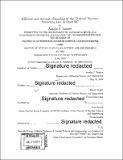| dc.contributor.advisor | Benoit Forget. | en_US |
| dc.contributor.author | Trainer, Amelia J. | en_US |
| dc.contributor.other | Massachusetts Institute of Technology. Department of Nuclear Science and Engineering. | en_US |
| dc.date.accessioned | 2020-01-08T19:43:59Z | |
| dc.date.available | 2020-01-08T19:43:59Z | |
| dc.date.copyright | 2019 | en_US |
| dc.date.issued | 2019 | en_US |
| dc.identifier.uri | https://dspace.mit.edu/handle/1721.1/123419 | en_US |
| dc.description | Thesis: S.M., Massachusetts Institute of Technology, Department of Nuclear Science and Engineering, 2019 | en_US |
| dc.description | Cataloged from PDF version of thesis. | en_US |
| dc.description | Includes bibliographical references (pages 76-77). | en_US |
| dc.description.abstract | Convenient access to accurate nuclear data, particularly data describing low-energy neutrons, is crucial to the quality of thermal nuclear reactor simulations. Obtaining the scattering kernel for thermal neutrons (i.e. neutrons with energy on the order of 1 eV or less) can be a difficult problem, since the neutron energy is not enough to break molecular bonds, and thus the neutrons must often interact with a molecule or lattice structure. The "scattering law" S([alpha] [beta]), which is a function of unitless momentum and energy transfer, is used to relate the frequency distribution (also called "vibrational density of states") of the scattering media, to the scattering kernel. Currently, the most popular method of calculating S([alpha] [beta]) involves running the LEAPR module of the NJOY nuclear data processing code. Several antiquated approximations are used in LEAPR, such as the Einstein-crystal approximation (i.e. discrete oscillator approximation), which represents peaks in the frequency distribution as 6-functions. This project identifies insufficiencies in current thermal scattering data preparation: redundant numerical operations, arbitrary summation cutoffs, the discrete oscillator approximation, and the requirement that input frequency distributions be provided on a uniform energy mesh. Solutions to these shortcomings are identified and discussed. Additionally, a recently developed method of sampling energies and angles of the scattered neutrons is implemented into the OpenMC Monte Carlo neutron transport code to facilitate the testing of better phonon representations and maintain the continuous representation of the scattering kernel in energy and angle.. | en_US |
| dc.description.statementofresponsibility | by Amelia J. Trainer. | en_US |
| dc.format.extent | 88 pages | en_US |
| dc.language.iso | eng | en_US |
| dc.publisher | Massachusetts Institute of Technology | en_US |
| dc.rights | MIT theses may be protected by copyright. Please reuse MIT thesis content according to the MIT Libraries Permissions Policy, which is available through the URL provided. | en_US |
| dc.rights.uri | http://dspace.mit.edu/handle/1721.1/7582 | en_US |
| dc.subject | Nuclear Science and Engineering. | en_US |
| dc.title | Efficient and accurate sampling of the thermal neutron scattering law in OpenMC | en_US |
| dc.type | Thesis | en_US |
| dc.description.degree | S.M. | en_US |
| dc.contributor.department | Massachusetts Institute of Technology. Department of Nuclear Science and Engineering | en_US |
| dc.identifier.oclc | 1134764266 | en_US |
| dc.description.collection | S.M. Massachusetts Institute of Technology, Department of Nuclear Science and Engineering | en_US |
| dspace.imported | 2021-02-02T15:41:55Z | en_US |
